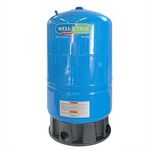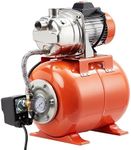Buying Guide for the Best Well Tank
When choosing a well tank, it's important to understand that this component plays a crucial role in your water system. A well tank stores water and maintains pressure, ensuring a steady supply of water to your home. Picking the right well tank involves considering several key specifications that will affect its performance and suitability for your needs. By understanding these specifications, you can make an informed decision that ensures reliable water pressure and supply for your household.Tank CapacityTank capacity refers to the amount of water the well tank can hold. This is important because it determines how much water is available before the pump needs to turn on again. Tank capacities can range from small (20-30 gallons) to large (over 100 gallons). For a small household with minimal water usage, a smaller tank may suffice. However, for larger households or those with higher water demands, a larger tank is more appropriate to ensure a consistent water supply and reduce the frequency of pump cycles.
MaterialWell tanks are typically made from steel, fiberglass, or composite materials. The material affects the tank's durability, weight, and resistance to corrosion. Steel tanks are strong and durable but can be prone to rust if not properly maintained. Fiberglass and composite tanks are lighter and resistant to corrosion, making them a good choice for areas with high humidity or corrosive water. Consider the environmental conditions and maintenance requirements when choosing the material of your well tank.
Pressure RatingThe pressure rating of a well tank indicates the maximum pressure it can handle. This is crucial for ensuring the tank can withstand the pressure from your water system without failing. Pressure ratings are usually measured in pounds per square inch (PSI). Common ratings range from 40 PSI to 100 PSI. To choose the right pressure rating, consider the pressure requirements of your water system and ensure the tank can handle slightly more than the maximum pressure to provide a safety margin.
Bladder vs. DiaphragmWell tanks can have either a bladder or a diaphragm to separate the water from the air. Bladder tanks have a flexible bladder inside that expands and contracts with water pressure, while diaphragm tanks have a rubber diaphragm that moves up and down. Both types are effective, but bladder tanks are generally easier to repair and maintain. Diaphragm tanks, on the other hand, tend to be more durable and less prone to wear and tear. Consider your preference for maintenance and durability when choosing between these two types.
Installation SpaceThe space available for installing the well tank is an important consideration. Well tanks come in various shapes and sizes, and you need to ensure that the tank you choose will fit in the designated area. Measure the available space and compare it with the dimensions of the tank. Additionally, consider the ease of access for maintenance and repairs. If space is limited, you may need to opt for a more compact tank or one with a vertical design.



















